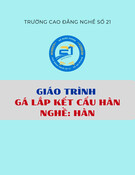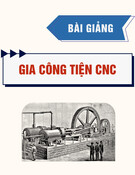
tionof the population contained between the smallest and the largest value
10 - I
0 a samp e size IS 10 + 1 = 11 . e meanIng 0 t e qua 1 cation on
the average" should be properly understood. For any particular sample of
size 10, the actual fraction of the population contained in the interval
X(N) X(1) will generally not be equal to Z:: But if the average of those
fractions is taken for many samples of size N, it will be close to Z::
Tolerance intervals involving confidence coefficients
One can formulate more specific questions related to coverages by in-
troducing, in addition to the coverage, the confidence of the statement about
the coverage. For example, one can propose to find two order statistics such
that the confidence is at least 90 percent that the fraction of the population
contained between them (the coverage) is 95 percent. For a sample of size
200, these turn out to be the third order statistic from the bottom and the
third order statistic from the top (see Table A30 in Natrella ). For further
discussion of this topic , several references are recommended.
Non-normal distributions and tests of normality
Reasons for the central role of the normal distribution in statistical theo-
ry and practice have been given in the section on the normal distribution.
Many situations are encountered in data analysis for which the normal distri-
bution does not apply. Sometimes non-normality is evident from the nature
of the problem. Thus , in situations in which it is desired to determine wheth-
er a product conforms to a given standard, one often deals with a simple di-
chotomy: the fraction of the lot that meets the requirements of the standard,
and the fraction of the lot that does not meet these requirements. Tbe statisti-
cal distribution pertinent to such a problem is the binomial (see section on
the binomial distribution).
In other situations, there is no a priori reason for non-normality, but the
data themselves give indications of a non-normal underlying distribution.
Thus, a problem of some importance is to "test for r.ormality.
Tests of normality
Tests of normality should never be performed on small samples , be-
cause small samples are inherently incapable of revealing the nature of the
underlying distribution. In some situations, a sufficient amount of evidence
is gradually built up to detect non-normality and to reveal the general nature
of the distribution. In other cases, it is sometimes possible to obtain a truly
large sample (such as that shown in Table 4. 1) for which normality can be
tested by "fitting a normal distribution" to the data and then testing the
goodness of the fit."5
Probability plots. A graphical procedure for testing for normality can
be performed using the order statistics of the sample. This test is facilitated
through the use of " normal probability paper " a type of graph paper on
which the vertical scale is an ordinary arithmetic scale and the horizontal
Simpo PDF Merge and Split Unregistered Version - http://www.simpopdf.com

Let represent the fraction of individuals having the stated character-
istic (serum glucose greater than 110 mg/dl) in the sample of size N; and let
= I -
p.
It is clear that for a relatively small, or even a moderately large
N, p will generally differ from P. In fact is a random variable with a well-
defined distribution function, namely the binomial.
The mean of the binomial (with parameter P) can be shown to be equal
to P. Thus
E(P)
==
(4. 24)
where the symbol E(P) represents the " expected value" of
p,
another name
for the population mean. Thus the population mean of the distribution of
equal to the parameter P. If is taken as an estimate for this estimate will
therefore be unbiased.
Furthermore:
V ar(p) = (4. 25)
Hence
p ~
( 4. 26)
The normal approximation for the binomial distribution
It is a remarkable fact that for a large the distribution of can be
approximated by the normal distribution of the same mean and standard de-
viation. This enables us to easily solve practical problems that arise in con-
nection with the binomial. For example , returning to our sample of 100 indi-
viduals from the population given in Table 4. , we have: ,.
E(P) = 0.
CT, (0, i~,785) ~ 0,0411
From these values , one may infer that in a sample of = 100 from the
population in question, the chance of obtaining values of less than 0.
(two standard deviations below the mean) or of more than 0. 30 (two standard
deviations above the mean) is about 5 percent. In other words , the chances
are approximately 95 percent that in a sample of 100 from the population in
question the number of individuals found to have serum glucose of more
than 110 mg/dl will be more than 13 and less than 30.
Since , in practice , the value of is generally unknown, all inferences
must then be drawn from the sample itself. Thus, if in a sample of 100 one
finds ap value of, say, 0. 18 (i. , 18 individuals with glucose serum greater
than 110 mgldl), one will consider this value as an estimate for and con-
sequently one will take the value
Simpo PDF Merge and Split Unregistered Version - http://www.simpopdf.com

(0. 18)(1 - 0. 18) = 0. 038
100
as an estimate for cr P' This would lead to the following approximate 95 per-
cent confidence interval for
0.18 - (1.96)(.038) .c P .c 0. 18 + (1.96)(. 038)
10 .c .c 0.
The above discussion gives a general idea about the uses and usefulness
of the binomial distribution. More detailed discussions will be found in two
general references.
Precision and accuracy
The concept of control
In some ways, a measuring process is analogous to a manufacturing
process. The analogue to the raw product entering the manufacturing proc-
ess is the system or sample to be measured. The outgoing final product ofthe
manufacturing process corresponds to the numerical result produced by the
measuring process. The concept of control also applies to both types ofproc-
esses. In the manufacturing process, control must be exercised to reduce to
, the minimum any random fluctuations in the conditions of the manufacturing
equipment. Similarly, in a measuring process, one aims at reducing to a mini-
mum any random fluctuations in the measuring apparatus and in the environ-
mental conditions. In a manufacturing process , control leads to greater uni-
formity of outgoing product. In a measuring process, control results in high-
er precision, I.e. , in less random scatter in repeated measurements of the
same quantity.
Mass production of manufactured goods has led to the necessity of inter-
changeability of manufactured parts, even when they originate from differ-
ent plants. Similarly, the need to obtain the same numerical result for a par-
ticular measurement, regardless of where and when the measurement was
made, implies that Local control of a measuring process is not enough. Users
also require interlaboratory control, aimed at assuring a high degree of "in-
terchangeability" of results , even when results are obtained at different
times or in different laboratories.
Methods of monitoring a measuring process for the purpose of achiev-
ing "local" (I.e. , within-laboratory) control will be discussed in the section
on quality control of this chapter. In the following sections, we will be con-
cerned with a different problem: estimating the precision and accuracy of a
method of measurement.
Within- and between-laboratory variability
Consider the data in Table 4.6, taken from a study of the hexokinase
method for determining serum glucose. For simplicity of exposition, Table
Simpo PDF Merge and Split Unregistered Version - http://www.simpopdf.com

scale is labeled in terms of coverages (from 0 to 100 percent), but graduated
in terms of the reduced z-values corresponding to these coverages (see sec-
tion on the normal distribution). More specifically, suppose we divide the
abscissa of a plot of the normal curve into 1 segments such that the area
under the curve between any two successive division points is ' The
division points will be Z2,
. . . ,
ZN, the values of which can be determined
from the normal curve. Table 4.5 lists the values ~ 2 ' . . . ,
' in percent , in column 1, and the corresponding normal values in
column 2, for 10. According to the general theorem about order statis-
tics, the order statistics of a sample of size = 10 " attempt" to accomplish
just such a division of the area into 1 equal parts. Consequently, the
order statistics tend to be linearly related to the values. The order statistics
for the first sample of Table 4.2 are listed in column 3 of Table 4.5. A plot of
column 3 versus column 2 will constitute a "test for normality : if the data
are normally distributed , the plot will approximate a straight line. Further-
more, the intercept of this line (see the section on straight line fitting) will be
an estimate of the mean, and the slope of the line will be an estimate of the
standard deviation.2 For non-normal data , systematic departures from a
straight line should be noted. The use of normal probability paper obviates
the calculations involved in obtaining column 2 of Table 4.5, since the hori-
zontal axis is graduated according to but labeled according to the values
~ 1 , expressed as percent. Thus, in using the probability paper, the ten
order statistics are plotted versus the numbers
100 -U ' 100 Tt '
. . . ,
100
or 9. 09, 18. 18, . . . , 90. 91 percent. It is only for illustrative purposes that we
have presented the procedure by means of a sample of size 10. One would
generally not attempt to u~e this method for samples of less than 30. Even
then, subjective judgment is required to determine whether the points fall
along a straight line.
In a subsequent section, we will discuss transformations of scale as a
means of achieving normality.
The binomial distribution
Referring to Table 4. , we may be interested in the fraction of the popu-
lation for which the serum glucose is greater than, say, 110 mgldl. A problem
of this type involves partitioning the range of values of a continuous variable
(serum glucose in our illustration) into two groups , namely: (a) the group of
individuals having serum glucose less than 110 mgldl; and (b) the group
individuals having serum glucose greater than 11 0 mgldl. (Those having se-
rum glucose exactly equal to 110 mgldl can be attached to one or the other
group, or their number divided equally among them.
Simpo PDF Merge and Split Unregistered Version - http://www.simpopdf.com

TABLE 4. 5. TEST OF NORMALITY USING ORDERSTATISTlCSa
Expected cumulative
areasb in percent Reduced normal
variate
Order statistics
of sample
09 -1.335
18. 18 -0.908
27.27 -0.604
36. 36 -0.348
45.45 -0.114
54. 54 0.114
63.64 0.348
72.73 0.604
81.82 0.908
90.91 1.335
Straight Line Fit of column 3 versus column 2:
Intercept == 107. 6 = P-
Slope = 15.5 = a-
91.9
96.
96.
97.
103.4
105.
112.
118.
119.
134.
aThe example is merely illustrative of the method. In practice one would never test normality on a sample
of size 10.
values of 100 + l ' where 10.
Suppose now that we have a random sample of only 100 individuals
from the entire population. What fraction of the 100 individuals will be found
in either group? It is seen that the binomial distribution has shifted the em~
phasis from the continuous variable (serum glucose) to the number of individ~
uals (or the corresponding fraction, or percentage) in each of the two
groups. There are cases in which no continuous variable was ever involved:
for example, in determining the number of times a six appears in throwing a
die. However, the theory of the binomial applies equally to both types of
situations.
The binomial parameter and its estimation
Let represent the fraction (I.e. , a number between zero and one) of
individuals in one of the two groups (e. , serum glucose greater than 110
mgldl) in the population. It is customary to represent the fraction for the oth~
er group by Q. Then it is obvious that 1 .- P. (If the fractions are ex~
pressed as percentages , we have percent = 100 - percent For the
data in Table 4. 1 and the dividing value 110 mgldl , we can calculate
using the normal distribution:
The reduced value corresponding to 110 mgldl is
110 - 100.42 = 0 79
12. 15
From the table of the normal distribution , we then obtain for
= 0. 215
Hence 1 - 0. 215 == 0. 785
Simpo PDF Merge and Split Unregistered Version - http://www.simpopdf.com










![Đề thi Công nghệ tạo hình dụng cụ năm 2020-2021 - Đại học Bách Khoa Hà Nội (Đề 4) [Kèm đáp án]](https://cdn.tailieu.vn/images/document/thumbnail/2023/20230130/phuong62310/135x160/3451675040869.jpg)









![Bài tập môn Cơ sở thiết kế máy [năm] [mới nhất]](https://cdn.tailieu.vn/images/document/thumbnail/2025/20251008/ltgaming1192005@gmail.com/135x160/26601759980842.jpg)


![Tài liệu huấn luyện An toàn lao động ngành Hàn điện, Hàn hơi [chuẩn nhất]](https://cdn.tailieu.vn/images/document/thumbnail/2025/20250925/kimphuong1001/135x160/93631758785751.jpg)


